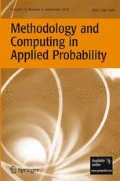Abstract
Risk indicators used in many applications usually involve certain transformations of the variables of interest, such as averages or maxima over given time periods or spatial regions, threshold exceedances, etc., or a combination of them. A common practice is to predict these indicators by applying the same type of transformation on the sample data, that is, the ‘historical’ values of the same indicators are used as the sample information set. In this work, the loss of information derived from the transformations defining the sample set is studied for different indicators and considering a flexible covariance model separating fractal dimension and memory. The evaluations and comparisons are performed in terms of predictive mutual information based on Shannon’s entropy. The results obtained for different scenarios suggest that, depending on the type of risk indicator considered and the dependence structure of the process of interest, the changes in terms of predictive information using diverse transformations of the observations may be substantial.
Similar content being viewed by others
References
Angulo JM, Ruiz-Medina MD, Alonso FJ, Bueso MC (2005) Generalized approaches to spatial sampling design. Environmetrics 16(2):523–534
Bueso MC, Angulo JM, Alonso FJ (1998) A state-space model approach to optimum spatial sampling design based on entropy. Environ Ecol Stat 5(1):29–44
Bueso MC, Angulo JM, Alonso FJ, Ruiz-Medina MD (2005) A study on sensitivity of spatial sampling designs to a driori discretization schemes. Environ Model Softw 20(7):891–902
Caselton WF, Zidek JV (1984) Optimal monitoring network designs. Stat Probab Lett 2:223–227
Cover TM, Thomas JA (2006) Elements of information theory. Wiley, New Jersey
Gneiting T, Schlather M (2004) Stochastic models that separate fractal dimension and the Hurst effect. SIAM Rev 46:269–282
Guttorp P, Le ND, Sampson PD, Zidek JV (1993) Using entropy in the redesign of an environmental monitoring network. In: Patil GP, Rao CR (eds) Multivariate environmental statistics. Elsevier, Amsterdam, pp 175–202
Le ND, Zidek JV (2006) Statistical analysis of environmental space-time processes. Springer, New York
Resnick SI (2007) Heavy-tail phenomena. Probabilistic and statistical modeling. Springer, New York
Rutanen K (2005) TIM library for efficient estimation of information-theoretic measures. http://www.cs.tut.fi/∼timhome/tim.htm
Tsallis C (2009) Introduction to nonextensive statistical mechanics. Approaching a complex world. Springer, New York
Whittaker J (1990) Graphical models in applied multivariate statistics. Wiley, Chichester
Author information
Authors and Affiliations
Corresponding author
Rights and permissions
About this article
Cite this article
Alonso, F.J., Bueso, M. & Angulo, J.M. Effect of Data Transformations on Predictive Risk Indicators. Methodol Comput Appl Probab 14, 705–716 (2012). https://doi.org/10.1007/s11009-011-9258-3
Received:
Accepted:
Published:
Issue Date:
DOI: https://doi.org/10.1007/s11009-011-9258-3




